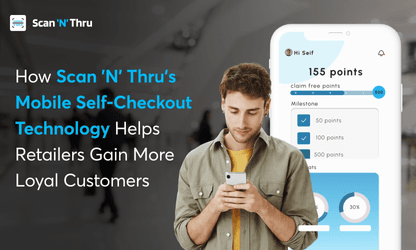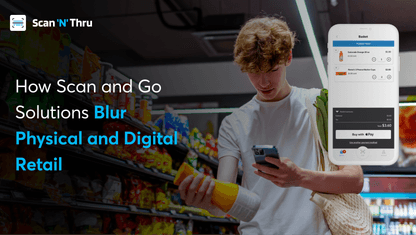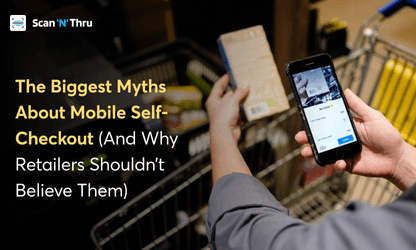Shoppers don’t abandon the checkout process because they dislike or have difficulty understanding the concept; they abandon their carts because something in the process slows them down.
Surprise: A recent NCR Voyix report revealed that 77% of customers opt for self-service checkout in physical stores because of faster service. So, if a system that is designed to make operations faster slows it down, then it needs some serious revamping.
A barcode won’t scan, the interface is clunky, or a payment method isn’t accepted. All these make the checkout process slow. In those moments, frustration outweighs convenience, and customers walk away with a poor experience.
For retailers like you, this isn’t just an occasional inconvenience—it’s a direct hit to customer satisfaction, operational efficiency, and even overall profitability.
A self-service checkout system should reduce checkout friction, not create more of it. Yet many retailers struggle to implement these systems effectively. But there are ways you can make these systems work seamlessly in your store.
In this blog, you will explore six key strategies that you can use to ensure your self-service checkout is seamless, efficient, and frustration-free. You’ll learn how to:
- Choose the right technology for your store’s needs
- Optimize scanning and payment options for a smoother checkout
- Enhance the experience with personalization and real-time assistance
Let’s get started.
1. Choose the right self-checkout technology
To provide a smooth in-store checkout experience, you have to start by choosing the right self-checkout technology for your store.
It isn’t just about slapping together a solution; it’s more about finding what works for your store. And yes, you guessed it right, there’s no one-size-fits-all solution here. Here’s what you should do:
Evaluate your store’s needs
Before you start, take a step back and ask these questions: What does my store really need? What kind of retail store do you have? Is it a cozy boutique where simplicity is key? Or are you managing a bustling grocery store with hundreds of SKUs? These factors matter.
You should think about customer flow in your store, the types of products you sell, and how tech-savvy your shoppers are.
Let’s see if you often sell bulky items or have certain products without barcodes, you’ll want a checkout system that can handle those quirks seamlessly.
Mobile self-checkout technology is quite apt in such scenarios because they’re flexible. Unlike self-checkout kiosks that are bolted to the floor, mobile checkout systems adapt to your store space and scale as your business grows.
Prioritize user-friendly systems
If your self-checkout system is too complicated and involves too many steps, then your customers will walk out faster than you can say “abandoned cart.”
So what’s the solution? Keep it simple. Every tap, swipe, or scan should feel intuitive.
Mobile self-checkout apps cut out the clutter by letting customers scan items directly with their smartphone cameras. They don’t have to fumble through menus or try to figure out hardware machines. Just scan, pay, and go. It’s a breath of fresh air—and exactly what modern shoppers crave.
2. Optimize scanning technology for accuracy and speed
Scanning might sound basic, but it’s the backbone of any self-checkout experience. Get it wrong, and frustration sets in among your customers. Get it right, and you’ve got happy, repeat customers. Here’s how you can do that:
Support multiple scanning methods
Realistically, it’s possible that every customer who walks into your store may not have a smartphone. Plus, some of your products may not have barcodes or sometimes barcodes may not work properly.
That’s why flexibility is crucial, and that why’s ideally you should offer multiple scanning options—smartphone cameras, dedicated scanners, or even manual entry. This way, every customer feels included, no matter their tech setup.
However, the way technology has blended with human lives means that you are likely to see most of your customers with smartphones. Besides, the number of people with smartphones is only going to increase. Statista predicts that the number of smartphone users worldwide is expected to grow by 1.8 billion between 2024 and 2029. That’s a 42.6% increase.
So, some customers may be a bit hesitant to use mobile self-checkout systems for now. But technology will become more and more accessible and people will get more comfortable with it. Hence, if you have a mobile-based checkout system then you are ready for the future.
Handle edge cases gracefully
Even the best systems hit snags sometimes—damaged barcodes, missing labels, or unscanned items. But here’s the thing: How you handle these moments defines the overall experience.
For starters, give your customers alternative ways to move forward. Maybe they can manually enter a product code or flag down a nearby staff member for help.
Speaking of staff, you should train them to anticipate these hiccups. If a barcode won’t scan, they should be ready to pull up the item info on an alternative device and keep things rolling. Smooth problem-solving keeps customers moving and tempers cool.
3. Streamline payment options for maximum convenience
Payment is the grand finale of the checkout process. If it’s complicated, then you risk losing the sale. Make it seamless, and you leave customers smiling. Here’s how you can do that: Include different payment options/methods
Shoppers have preferences—and lots of them. Some love tapping their phone for Apple Pay, others swear by contactless cards, and a few may still prefer good old-fashioned cash. The bottom line? You need to cater to all of them.

By integrating a mix of payment methods, you remove friction and open the door to more sales. Think about it: A customer who can’t pay the way they want is a customer who might walk out empty-handed. Don’t let that happen.
Enable split payments when necessary
Sometimes, your customers may want to split their payment between different methods, such as combining a gift card with a credit card. So, having this flexibility prevents last-minute checkout frustrations and it also ensures that your customers complete their purchases without any unnecessary hassle.
Read more: How Scan, Pay, and Go Technology is Changing Retail Payments
4. Provide real-time assistance
No matter how smooth your system is, questions will pop up. And when they do, you need to be ready to help, and that too in a timely manner. Here’s what you can do to do that:
Implement live chat or chatbots (via mobile self-checkout app)
A built-in chat feature can be really helpful for your customers to get quick answers to some common questions/issues. This means your staff members won’t have to get involved unless it’s really urgent or necessary. Besides, getting support directly from the self-service checkout app keeps the experience cohesive.
Deploy on-floor staff strategically
Sometimes your customers would just want to talk to a human. It could be because they are unable to sort out the issue themselves or they want some help.
That’s where your store team comes in. They must be trained to manage stock levels, handle customer complaints, or be ready to jump in wherever they are needed.
Their presence reassures customers that help is nearby, which builds confidence in the system.
Apart from that let’s not forget the security aspect—well-placed staff can deter theft without making honest shoppers feel like they’re under suspicion.
5. Personalize the experience with smart features
The self-service checkout process is also an opportunity for businesses like yours to build strong customer relationships. When you introduce personalization into it, then it turns a routine transaction into an engaging and tailored experience.
Here’s how you can do that:
Recognize returning customers automatically
Loyal customers appreciate when their shopping preferences are remembered. A mobile-based self-service checkout system can recognize your returning customers in multiple ways.
You can leverage loyalty programs or login credentials to tailor the experience. Plus, features like pre-fill payment details, automatic discounts, and product suggestions based on past purchases go a long way in building loyalty.

Suggest add-ons based on purchase history
Cross-selling doesn’t have to feel pushy. In fact, it can feel downright helpful. You can recommend complementary items through self-service checkout apps to your customers before they finalize a purchase.
6. Gather feedback to continuously improve the customer experience
The best retailers know that improvement never stops and they also realize that a great self checkout system in retail can be constantly upgraded with customer feedback. Actively seeking feedback helps you stay ahead of the curve.
Here’s what retailers like you can do to check what works and what frustrates your shoppers so that you can refine the customer experience over time.
Use post-checkout surveys
After a purchase, invite customers to share their thoughts. Keep it short and sweet—just a couple of questions about ease of use and overall satisfaction. Throw in a discount code as a thank-you, and watch response rates climb.
Monitor analytics for insights
Behind the scenes, dig into the data. Track metrics like abandonment rates, error frequency, and average checkout times. These numbers tell a story.
For example, if lots of users drop off during payment, it could signal confusion over available options. Fixing these pain points keeps your system sharp and your customers happy.
Final thoughts
Every checkout experience leaves an impression. When it's seamless, customers barely notice—it just works. But when it’s clunky or frustrating, they remember, and not in a good way.
The key is to focus on the details that matter most:
- Intuitive technology
- Accurate scanning
- Flexible payments
- Real-time support
- Personalized experiences
- Smart Features
These elements work together to create a checkout process that feels smooth and easy to use.
Scan 'N' Thru makes all of this easy by integrating mobile self-checkout with personalized rewards, real-time assistance, and seamless payment options. This ensures your customers leave satisfied, every time.
If you refine your store’s checkout process now, you will be better positioned to meet evolving customer expectations and stay ahead of the curve. If your goal is to streamline operations while improving customer satisfaction, investing in the right self-service checkout solution like Scan ‘N’ Thru is your first step toward long-term success.




